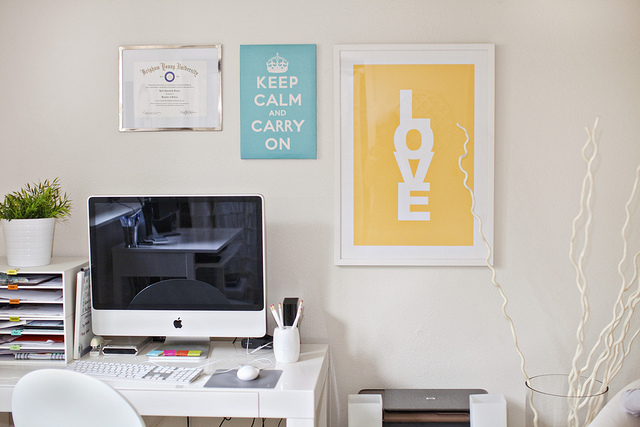
Dwell :: 5 Steps To a More Productive and Sustainable Home Office
Many of us work-at-home parents, home business owners and freelance writers spend hours behind closed home office doors. I’m sure we all have the standard amenities for getting our work finished – computer, desk, some sort of lighting for the wee hours of the night binges to meet deadlines, etc. The question I often find myself asking at the end of the day is; do I feel like I have had a productive work day? Could I be more productive if I make a few changes to your home office setup or my work routine?
Usually, when we are plan out how we’re going to setup our home office, we often focus on the mundane things like where we are going to put our stylish home computer desks or which outlet the printer is going to plug into so we don’t trip over the cord later. Unfortunately, in our rush to get things going, we tend to throw productivity and sustainability out the window without a second thought.
Be smart about your electronics and software
If you want to reduce your environmental footprint in a dramatic way being smart about the electronic devices and software you make use at home. The amount of business applications now available on web-based platforms is staggering. These types of cloud-based services reduce the need for you to maintain a power-hungry infrastructure at home just to host your business applications, thereby producing less carbon.
In addition, cloud technology can save you even more money and streamline your productivity if you also take advantage of its virtual storage capabilities. This allows you to reduce the scale of your equipment needs and allow you to run any home based business with just few tablets, cell phones or laptops which all consume significantly less energy than bulky desktops.
Ergonomically friendly, just do it
Productivity can be negatively impacted because of several health issues such as improper posture when your office is not set up properly. Setting up your office to be more ergonomic requires you to streamline your tools and tasks to fit your capabilities and limitations so you’re able to complete all of your daily tasks without them resulting in injury. This makes it sound harder, and more expensive, than it actually is don’t you think?
Simple fixes include regularly engaging in an exercise routine that strengthens and stretches your back and making sure have a desk chair that reclines slightly to reduce pressure on your vertebrae. You can also equip it with a mesh back support.
When sitting at your desk, you want to ensure that your monitor is at or just below eye level and your eyes are approximately 24 to 36 inches from the screen and use a foot rest to reduce back strain. In addition, a chair that reclines slightly reduces pressure on your vertebrae so there is less chance of injuring your back.
Turn off unused equipment
I have to admit that even I forget this tip from time to time. Leaving my computer in standby mode and leaving copier idling isn’t a catastrophe but you could realistically get what equates to about a free month’s worth of electricity each year just by powering down unused appliances and equipment.
Even though the devices are not fully active, they are still drawing power when running. This wastes a large amount of electricity over the course of a year and while it doesn’t exactly reach catastrophe level magnitude you could realistically save what equates to about a free month’s worth of electricity each year just by powering down and unplugging unused appliances and electronics in your home.
Recycle, recycle, recycle and reuse
Many of the office supplies we use regularly like folders binders pens and paper clips can be reused over. In addition, office supplies like paper products, ink cartridges, binders and even electronics can be recycled. Since the materials don’t have to be re-harvested and refined to produce more, using recycled office supplies and adopting a strategy of “use less and reuse more” saves energy and resources.
Nature adds to productivity
Nature is a critical component of our psychological and physiological well-being and it restores mental functioning in much the same way that food and water restores the body. University of Michigan researchers even found that performance on memory and attention tests can be improved by as much as 20-percent after subjects went for a walk through an arboretum.
To take advantage of this natural performance booster, try locating your desk near a window so and take advantage of the benefits of natural lighting. If you don’t have windows in your office, hanging a few photos of nature and adding a few live plants to increase the oxygen in the room and some fresh cut flowers for color and brightness just might do the trick.
Photo courtesy of Flickr:
Photo courtesy of Flickr:
0



2 Comments
Alex Goodwin
Thank you for giving me the opportunity to share my article with you and your readers. Hope you enjoy.
Regus
With the advent of digital technology, we have become bombarded with too much visual and auditory stimulation. To prevent that, we should add a touch of nature to our home offices.